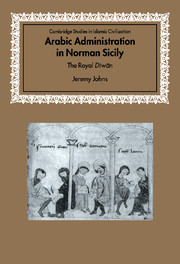Book contents
- Frontmatter
- Contents
- Preface
- Tables
- Abbreviations
- Genealogical table of the De Hautevilles of Sicily
- Note on Measurements
- Introduction
- 1 ‘In the time of the Saracens …’
- 2 ‘When first the Normans crossed into Sicily …’
- 3 ‘Our lady, the Regent Adelaide, and our Lord, the Count Roger, her son’, 1101–30
- 4 The earliest products of the royal dīwān, 1130–43
- 5 The jarāʾid renewed, 1144–5
- 6 The records of the royal dīwān. Part I: the jarāʾid al-rijāl
- 7 The records of the royal dīwān. Part II: the dafātir al-ḥudūd
- 8 The duties and organisation of the royal dīwān, 1141–94
- 9 ‘The people of his state’. The ‘palace Saracens’ and the royal dīwān
- 10 The Norman dīwān and Fāṭimid Egypt
- 11 Royal dīwān and royal image
- Appendix 1 Catalogue of dīwānī documents
- Appendix 2 Provisional catalogue of private documents
- Appendix 3 Abū Tillīs – ‘Old Wheat-sack’
- List of References
- Index
- Titles in the series
Appendix 2 - Provisional catalogue of private documents
Published online by Cambridge University Press: 10 March 2010
- Frontmatter
- Contents
- Preface
- Tables
- Abbreviations
- Genealogical table of the De Hautevilles of Sicily
- Note on Measurements
- Introduction
- 1 ‘In the time of the Saracens …’
- 2 ‘When first the Normans crossed into Sicily …’
- 3 ‘Our lady, the Regent Adelaide, and our Lord, the Count Roger, her son’, 1101–30
- 4 The earliest products of the royal dīwān, 1130–43
- 5 The jarāʾid renewed, 1144–5
- 6 The records of the royal dīwān. Part I: the jarāʾid al-rijāl
- 7 The records of the royal dīwān. Part II: the dafātir al-ḥudūd
- 8 The duties and organisation of the royal dīwān, 1141–94
- 9 ‘The people of his state’. The ‘palace Saracens’ and the royal dīwān
- 10 The Norman dīwān and Fāṭimid Egypt
- 11 Royal dīwān and royal image
- Appendix 1 Catalogue of dīwānī documents
- Appendix 2 Provisional catalogue of private documents
- Appendix 3 Abū Tillīs – ‘Old Wheat-sack’
- List of References
- Index
- Titles in the series
Summary
1. Undated [12th-century?]
A contemporary copy (?) of an Arabic deed of sale, with Greek notes. Al-Ghuman (‘the abbot’ < Greek ἡγούμενος, ēgoumenos) ibn al-qissīs (‘son of the priest’) Abū Ghālib, lord of the monastery of Barḍālī (?) purchases from ‘Umar ibn Ḥusayn al-Tamīmī, known as Ibn Ṣāfī, a piece of land known as Khandaq Iblaṭa (or Iblaṭuh), for the price of five tarì (rubāʿīiya). (The place-name has been identified implausibly with ἡ ϕαβάρα … ἠβλάτου, Fawwāra Iblāṭū, near Partinico: Caracausi 1990, p.225). The witnesses: Abd al-Ghanī ibn Ibrāhīm al-Lawāti; al-shaykh Maymūn ibn Ḥasan al- Tamimi; Yūsuf ibn Abū (sic!) Bakr al-Haww?ri; Abū l-Faraḥ (or al-Faraj?) ibn Ḥusayn al-Kutāmī; Alī ibn Ḥusayn al-Lawātī; Bū Jumfia ibn Yūsuf al-Rabīfī(?)
Original: PA, AdS, Cefalù, no.38. Ed. Cusa 1868–82, no.14, pp.505–6 (reg. p.698); trans. Trovato 1949, pp.76–7.
- Type
- Chapter
- Information
- Arabic Administration in Norman SicilyThe Royal Diwan, pp. 315 - 325Publisher: Cambridge University PressPrint publication year: 2002

